PHOENIX — Arizona’s rate of new infections of COVID-19 is skyrocketing.
There were nearly 27,000 new confirmed cases in the most recent seven-day period available, an analysis of figures by Capitol Media Services shows.
That’s nearly 3,700 new infections this past week for every million Arizona residents.
The New York Times, looking at its own data set, puts the figure at closer to 3,300. But even at that, the rate of new infections here, computed at a rate of per million residents, is higher not just than any state in the country but any other country in the world, the Times says in its analysis.
That conclusion is “misleading and inaccurate,” said Patrick Ptak, a spokesman for Gov. Doug Ducey. And part of that, Ptak said, is that Arizona is doing so much more testing than other countries.
But other data analyzed by Capitol Media Services shows the trend is not headed in the right direction.
On a seven-day average, Arizona is now adding 3,452 new cases each and every day, the Biodesign Institute at Arizona State University figures.
In June, the figure was 843.
In May it was 337 new cases each day on average.
And in April it was just 191.
Much of the increase comes in the wake of decisions made by Ducey to loosen the restrictions he had placed both on individual travel and the kinds of businesses that could be open.
Ducey, facing rising numbers of the coronavirus across the state, has backtracked.
The governor, who for months refused to order Arizonans to wear masks — and would not wear one himself while out in public — relented a bit last month and agreed to allow local officials to impose their own mask requirements.
And last week, as the numbers headed still higher, he reversed course and reclosed bars, water parks, gyms and fitness centers.
Ducey also said movie theaters also had to close, though most had not yet reopened following his original emergency order in March.
State health director Cara Christ says the good news is that the rate of positive tests has stabilized.
“And, also, the rate of growth is slowing,” Christ said.
Christ said she expects to start seeing results from the governor’s more recent actions — the mask permission and the closure of certain businesses — “probably by the end of next week.” In the meantime, the health director said she will continue to emphasize her message that “you really are safer at home.”
If people decide to go out, she said, they need to “assess their risks,” looking at the number of people to whom they are going to be exposed, how close they will be to those people and for what period of time.
And if that doesn’t bring down the numbers?
Christ said the most effective move would be to once again disallow dine-in services at restaurants “where you know that people are going to be sitting for longer periods of time in an enclosed area, potentially close to other people.”
She said a better alternative is to encourage takeout or at least have people dine outside “because the better ventilation is going to decrease the risk of transmission.”
Christ said she agrees with Ptak that Arizona should not be measured against infection rates elsewhere.
“I don’t believe that it’s fair to compare us to other countries that may not have the same access or ability to test their citizens,” she said.
Arizona on Tuesday got the results from 12,212 PCR tests, Ptak said. Those are the ones that determine an active case, versus serology tests which determine if someone had it in the past and has developed antibodies.
That, Ptak said, works out to 167 tests per 100,000 residents. By contrast, he said, Brazil is testing just 0.025 residents per 100,000.
And in both Brazil and Peru, he said, the positivity rate is higher.
“This, in combination with their much lower testing, suggests the outbreaks in these places are much larger than is being reported,” Ptak said. And he said that the positivity rate in Arizona now is less than half of what it was when New York hit its peak.
But that tells only part of the story.
Figures from Johns Hopkins University show half of the tests run in New York came back positive in early April. But in that state, which imposed strict controls, there has been a steady decline to the point where just 1.1% of all tests now are positive.
By contrast, Arizona has seen a steady increase in positive tests since the middle of May. It now stands at about 25%.
The timing of that is not coincidental.
It was on May 8 that Ducey agreed to allow barbershops and beauty salons to reopen, albeit with restrictions.
Restaurants were once again allowed to begin sit-down service on May 11, here, too, with limits on the number of people who can be inside.
And on May 16, the governor’s order for people to stay at home except to participate in “essential” activities and services expired.
The result is that 25% of tests are coming back positive, versus less than 7% before Ducey eased the restrictions.
On Wednesday, the Department of Health Services reported 36 new deaths, bringing the statewide total to 1,963. There also were 3,520 new cases, with 108,614 Arizonans who at one point or another have been infected.
State health officials say the most recent figures show there were a record 3,421 hospital beds occupied by positive or suspected COVID-19 patients.
That’s more than the number of patients hospitalized for any other reason. Overall, 6,784 of the state’s regular hospital beds were occupied, 85% of the regular capacity.
The situation was even more pronounced for intensive-care units, where there are 871 COVID-19 patients, also a record. Patients in ICUs for other reasons were only about 600, with total occupancy now at 91%.
Part of what makes those numbers critical is that the state health department has agreed to allow hospitals to implement the state’s “crisis standards of care.” That would permit them to triage patients, the way they would during a natural disaster, “to optimize health-care resources and do the greatest good for the greatest number of patients.”
Put another way, it decides who is to be treated, and in what order, including who gets into intensive-care units.
And what that also means, according to the state plan, is providing “comfort care” to patients “for whom curative therapies are futile, given available resources.”
Christ said she knows of no hospital that has implemented those standards.
Photos for May 29: Tucson gets by during Coronavirus Pandemic
Tucson gets by during coronavirus pandemic
Updated
The iconic Casa Molina bull and matador statue both sport masks on the first full week of the loosening of COVID19 restrictions, May 23, 2020, Tucson, Ariz. The bull previously had a mask on the testicles.
Tucson gets by during coronavirus pandemic
Updated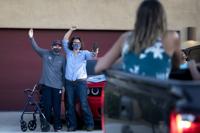
Michelle Leon Cordova, right, mother, and her son Sahuarita High School senior Lino Cordova, whom is fighting cancer, wave at staff members from Diamonds Children Center, friends and the Marana Police Department during a car parade, celebrating Lino's graduation, outside of his home on May 13, 2020 in Sahuarita, Ariz. Cordova stood on the sidewalk while the team from Diamond Children Center, friends and the Marana police department gave Cordova a graduation gar parade. Cordova was given a gift basket with his favorite snacks, gift cards as well as other items he enjoys. The car parade, also, celebrated another graduating senior fighting cancer from Empire High School, Noah Nieto. Nieto, also, received a gift basket with snacks, gift cards and other items Lino enjoys.
Tucson gets by during coronavirus pandemic
Updated
Michelle Leon Cordova, right, mother, brings celebration balloons to a car after staff members from Diamonds Children Center, friends and the Marana Police Department celebrate Sahuarita High School senior Lino Cordova, whom is fighting cancer, graduation with a car parade outside of his home on May 13, 2020 in Sahuarita, Ariz. Cordova stood on the sidewalk while the team from Diamond Children Center, friends and the Marana police department gave Cordova a graduation gar parade. Cordova was given a gift basket with his favorite snacks, gift cards as well as other items he enjoys. The car parade, also, celebrated another graduating senior fighting cancer from Empire High School, Noah Nieto. Nieto, also, received a gift basket with snacks, gift cards and other items Lino enjoys.
Tucson gets by during coronavirus pandemic
Updated
Personnel from Tucson Medical Center line the heliport to watch A-10's from Davis-Monthan Air Force Base's 355th Wing and F-16's from the Arizona Air National Guard's 162nd Wing make a pass over the facility, one leg of an area wide community flyover, May 14, 2020, Tucson, Ariz.
Tucson gets by during coronavirus pandemic
Updated
Nancy Celix-Campos, right, a respitory therapist at Tucson Medical Center, watches the military flyover with her daughters, Giana, 12, and Jazmyn, 8, from Sentinel Peak on May 14, 2020. Two F-16 Fighting Falcons from Arizona Air National GuardÕs 162nd Wing and two A-10 Thunderbolt II's from the 355th Wing, assigned to Davis-Monthan Air Force Base, fly over Tucson area hospitals to honor healthcare personnel and first responders as they are some of the frontline workers dealing with the coronavirus disease (COVID-19) head on. "It's been an exhausting two to three months," says Campos, "it's pretty cool, I like how they're going by each hospital."
Tucson gets by during coronavirus pandemic
Updated
Two F-16 Fighting Falcons from Arizona Air National Guard’s 162nd Wing and two A-10 Thunderbolt II's from the 355th Wing, assigned to Davis-Monthan Air Force Base, fly over Northwest Medical Center north of Tucson on May 14, 2020.
Tucson gets by during coronavirus pandemic
Updated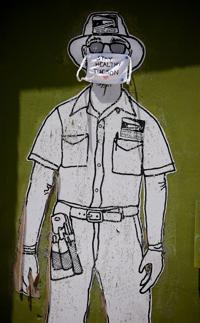
A letter carrier portrait on the Ok Market building, located in the Armory Park neighborhood, is adorned with a face mask on May 18, 2020.
Tucson gets by during coronavirus pandemic
Updated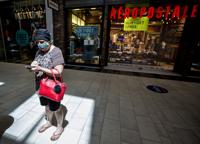
Rosemary Garcia waits for a family member outside of a store at Park Place Mall, 5870 E. Broadway Blvd., in Tucson, Ariz. on May 19, 2020. Malls reopened today under CDC guidelines and Gov. Ducey's new rules for businesses due to the Coronavirus pandemic. Park Place Mall has signs throughout the mall reminding customers to keep a six feet distance as well as hand sanitizer stations near each entrance. About half of the tables in the food court have been removed to allow for social distances as well as less than half of the stores have opened with new guidelines. Of the stores open, only 10 customers are allowed to shop in each store at a time.
Tucson gets by during coronavirus pandemic
Updated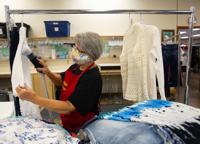
Pat Schlote steams clothing before it is put on the sales floor at the Golden Goose Thrift Shop in Catalina, Ariz., on May 21, 2020.
Tucson gets by during coronavirus pandemic
Updated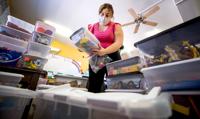
Ada Contreras, teaching assistant, looks through containers while reorganizing toys at Herencia Guadalupana Lab School, 6740 S. in Tucson, Ariz. on May 21, 2020. As Child care centers begin to re-open when they are ready, Herencia Guadalupana Lab School is reorganizing and cleaning everything in the facility before re-opening on June 2. To allow for social distancing and decrease the amount of items children touch, Herencia Guadalupana Lab School has sheds where items will go as well as placing items in containers organized by category.
Tucson gets by during coronavirus pandemic
Updated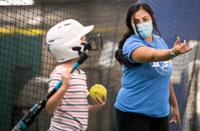
Jen Martinez, right, softball coach, teaches Skylar Reilly about hitting during a session at Centerfield Baseball Academy, 5120 S. Julian Dr., in Tucson, Ariz. on May 21, 2020. After re-opening on Monday, Centerfield Baseball Academy has implemented new policies in response to the Coronavirus Pandemic such as wearing masks, cleaning, signage, hand sanitizer and limiting the amount of people inside the facility.
Tucson gets by during coronavirus pandemic
Updated
Karl Bosma, left, and George Cantua, with facilities and maintenance, lay down stickers to mark six-foot separation distance around one of the baggage carousels, part of the efforts at Tucson International Airport to work within the restrictions of COVID19, May 22, 2020, Tucson, Ariz.
Tucson gets by during coronavirus pandemic
Updated
A lone passenger waits for a flight near one of the shuttered restaurants in the B Gates before Memorial Day at Tucson International Airport on May 22, 2020.
Tucson gets by during coronavirus pandemic
Updated
Drew Cooper on the stage in the St. Philip's Plaza courtyard, May 22, 2020, Tucson, Ariz., where live music is back on the schedule.
Tucson gets by during coronavirus pandemic
Updated
Many people visit Tumamoc Hill during the first day of Tumamoc's re-opening in Tucson, Ariz. on May 25, 2020. After being closed due to the Coronavirus pandemic, Tumamoc Hill re-opened with some modifications. There are hand sanitizer stations throughout the hike to the top as well as arrows, spaced 10-ft apart, lined up and down the hill. Some runners, hikers and walkers are also wearing masks during their hike. "The steps we are taking aim to provide our community with needed exercise, connection to our beautiful desert and a sense of comfort in such a trying time, while balancing the fact that gathering as a community endangers each of us and our loved ones. This is an unprecedented challenge that we are taking extremely seriously," said Benjamin T. Wilder, director of Tumamoc Hill. Visitors are also asked to limit their group to three people and to not touch the gate at the top of the hill- a tradition for some who make it to the top. "This is a time when we need to establish new traditions and adapt in a creative manner that embraces empathy, unity, care and patience," Wilder said.
Tucson gets by during coronavirus pandemic
Updated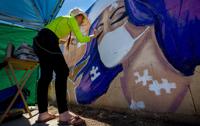
Pen Macias, artist, works on part 2 of a mural for a client on E. Broadway Rd., between S. Columbus Blvd. and S. Alvernon Way, in Tucson, Ariz. on May 25, 2020. Macias, known as The Desert Pen, has been working on her clients mural for the past three months. "It's the one thing I love, I have a passion for and the only thing I could be happy doing," said Macias. The mural represents her client, a single mother of four who works in the health care field. One half of the mural is dedicated to the connection between mothers and their children. The other half is dedicated to the connection between nurses and patients. The client wanted some positivity in the mural to show how nurses give a piece of themselves to their patients hence the puzzle pieces in the nurse and the patients, said Macias.
Tucson gets by during coronavirus pandemic
Updated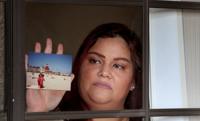
Christina Cortinas, posing at her home, May 28, 2020, Tucson, Ariz., with a photo of her and her mother, Catherine Rodriguez, in San Diego, 1991. Rodriguez is currently in assisted living and fighting COVID19. Cortinas hasn't seen her mother in months, the longest such span in her life.
Tucson gets by during coronavirus pandemic
Updated
Ruben Lopez looks through handouts while attending a Eviction Resource Fair with his family outside the Pima County Justice Court.



